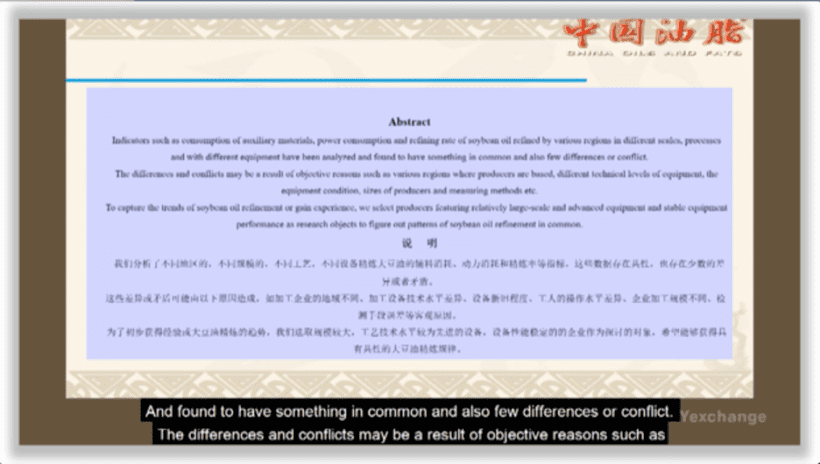
By Brandelyn Twellman
Point of origin can have an impact on the quality of soybean oil. While refiners have recognized this impact for years, there has been a lack of both quantitative and qualitative evidence to reference on the subject. Panelists at the U.S. Soy Global Trade Exchange & Specialty Grains Conference presented an inside look at research that aims to close this gap.
“For years, USSEC, as well as industry, has been hearing that the refining of soybean oil is in part affected by the origin of the oil, due in part to the growing conditions, storage, harvest, as well as weather,” said Will McNair, USSEC Director of Human Utilization, while introducing a session on U.S. soy oil’s refining advantage. “These factors help to affect the refining cost, as well as the overall production of soybean oil.”
Dr. Fan Yang of COFCO Engineering (Xi’an) International Co., Ltd. presented his initial research on the characteristics of refined soybean oil in different countries. His focus was its impact on crude oil quality, refining consumption and refining rate. He also took a look at resulting cost estimates for processing.
Yang said both pre- and post-harvest conditions can contribute to point of origin’s effect on soybean oil quality. After looking at the differences in refined soybean oil from various countries, he was able to conclude U.S. Soy showed certain advantages based on its consumption and refining rate.
His findings have created a launch pad for other research into the impact of origin. Todd Doehring of Centrec Consulting Group, LLC introduced plans for a research project focusing on the value of processing U.S. soybean oil compared to that of South American origins.
“It has been observed and noted that international refiners have a decreased cost of processing soybean oil produced from the U.S. versus soybean oil produced from South American origins, specifically Brazil and Argentina. A survey and an economic study are essential to raise the bar from anecdotal evidence to actual benefits of U.S. soybean oil.”
-Todd Doehring, Centrec Consulting Group, LLC
The study aims to quantify the cost differences in refining oil from various origins by identifying oil characteristics that contribute to these variances. Richard Galloway of Galloway & Associates, LLC said they expect to see results complementary of Yang’s findings.
“Our primary expectations are that we’ll find higher neutral oil loss due to higher free fatty acids experienced in South American soybean oil,” Galloway said. “Also, an increased use of bleaching medium due to the higher color of South American crude soybean oil. Given the assumptions about a specific refiner’s cost structure, these general differences in quality can be used to value these differences for a specific refiner.”
The group plans to use refiners’ expense structures to utilize the findings of their research to develop a type of calculator that allows for specific cost comparisons.
“Based on the information we collect from this survey based on these intrinsic quality factors, we’ll use that information to see a model that will then allow us to compare the refining cost differences between two different origins of soybean oil,” said Micah Pope of Centrec Consulting Group, LLC. “We’ll be creating a soybean oil valuation tool. The objective of this tool will be to estimate what the economic costs are of refining U.S. soybean oil versus the cost of refining soybean oil from South America.”
The tool will allow for data input, enabling individualized cost comparisons. The calculator takes research in this area a step further, Galloway added. It represents a tangible outcome of this important research into the impact of origin on soybean oil quality.
